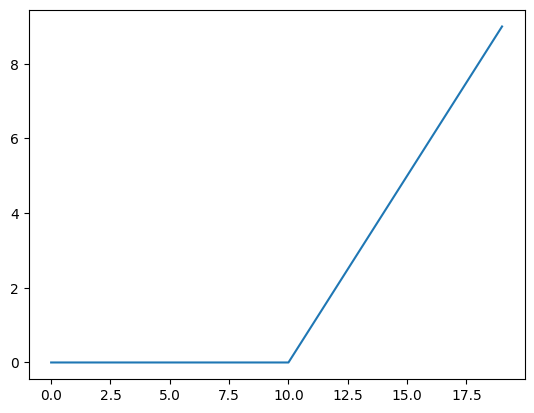
See also:
- Fun, fun, tensors: Tensor Constants, Variables and Attributes, Tensor Indexing, Expanding and Manipulations, Matrix multiplications, Squeeze, One-hot and Numpy
- Tensorflow 2 - Neural Network Regression: Building a Regression Model, Model Evaluation, Model Optimization, Working with a "Real" Dataset, Feature Scaling
- Tensorflow 2 - Neural Network Classification: Non-linear Data and Activation Functions, Model Evaluation and Performance Improvement, Multiclass Classification Problems
- Tensorflow 2 - Convolutional Neural Networks: Binary Image Classification, Multiclass Image Classification
- Tensorflow 2 - Transfer Learning: Feature Extraction, Fine-Tuning, Scaling
- Tensorflow 2 - Unsupervised Learning: Autoencoder Feature Detection, Autoencoder Super-Resolution, Generative Adverserial Networks
Tensorflow Neural Network Classification
Classification Problems
- Binary Classifications
- Multiclass Classifications
- Multilabel Classifications
import tensorflow as tf
import matplotlib.pyplot as plt
import numpy as np
import pandas as pd
from sklearn.datasets import make_circles
Working with Non-Linear Datasets
# creating data
n_samples = 1000
X, y = make_circles(n_samples,
noise=0.03,
random_state=42)
# check features and labels
X, y
# (array([[ 0.75424625, 0.23148074],
# [-0.75615888, 0.15325888],
# [-0.81539193, 0.17328203],
# ...,
# [-0.13690036, -0.81001183],
# [ 0.67036156, -0.76750154],
# [ 0.28105665, 0.96382443]]),
# array([1, 1, 1, 1, 0, 1, 1, 1, 1, 0, 1, 0, 1, 1, 1, 1, 0, 1, 1, 0, 1, 0,
# 0, 1, 0, 0, 0, 1, 1, 1, 0, 0, 1, 0, 0, 0, 1, 1, 1, 0, 0, 0, 0, 1,
# 0, 0, 1, 1, 0, 1, 1, 1, 0, 1, 0, 0, 1, 0, 0, 1, 0, 0, 1, 0, 1, 1,
# 1, 1, 0, 1, 0, 0, 1, 1, 0, 0, 1, 0, 1, 0, 1, 0, 0, 0, 0, 1, 1, 1,
# 1, 0, 0, 0, 1, 0, 1, 0, 1, 0, 0, 1, 1, 0, 1, 0, 1, 1, 1, 1, 0, 1,
# 1, 1, 1, 1, 0, 0, 0, 1, 1, 0, 1, 0, 1, 0, 0, 1, 1, 0, 1, 1, 1, 1,
# 0, 1, 1, 0, 0, 0, 0, 0, 0, 0, 1, 0, 1, 1, 1, 0, 1, 0, 1, 0, 1, 0,
# 1, 0, 0, 1, 0, 1, 1, 1, 1, 1, 1, 1, 0, 1, 0, 0, 0, 0, 0, 1, 0, 0,
# 0, 0, 1, 1, 0, 1, 0, 1, 1, 0, 0, 0, 1, 1, 1, 1, 1, 0, 0, 0, 0, 0,
# 1, 0, 0, 1, 1, 1, 1, 1, 0, 1, 0, 1, 0, 0, 1, 1, 1, 0, 1, 0, 1, 1,
# 0, 1, 1, 0, 1, 0, 1, 0, 1, 1, 0, 1, 0, 1, 0, 0, 0, 1, 0, 0, 0, 0,
# 1, 1, 0, 0, 0, 0, 0, 0, 0, 1, 1, 1, 0, 0, 1, 1, 1, 0, 1, 0, 0, 0,
# 0, 1, 1, 0, 1, 0, 0, 0, 1, 0, 1, 0, 0, 1, 0, 1, 1, 1, 0, 0, 0, 1,
# 0, 0, 0, 1, 1, 1, 1, 0, 0, 0, 1, 0, 0, 0, 1, 0, 0, 0, 1, 1, 0, 1,
# 1, 1, 1, 1, 1, 1, 0, 0, 0, 0, 1, 0, 0, 0, 0, 1, 1, 1, 0, 0, 1, 0,
# 1, 0, 1, 1, 0, 0, 1, 1, 1, 1, 0, 0, 0, 0, 0, 0, 1, 1, 0, 1, 0, 0,
# 1, 0, 0, 0, 0, 0, 0, 0, 0, 1, 0, 0, 0, 0, 1, 0, 0, 1, 0, 1, 0, 0,
# 0, 1, 0, 0, 1, 1, 0, 0, 1, 0, 0, 1, 1, 0, 1, 1, 0, 0, 1, 0, 1, 0,
# 0, 0, 1, 1, 0, 0, 1, 1, 1, 1, 1, 0, 0, 1, 1, 1, 1, 0, 1, 1, 1, 1,
# 1, 0, 0, 1, 0, 1, 0, 0, 0, 0, 1, 0, 0, 0, 0, 0, 0, 0, 0, 0, 1, 1,
# 0, 1, 1, 1, 1, 1, 1, 0, 1, 1, 1, 1, 0, 0, 0, 1, 1, 1, 0, 0, 0, 0,
# 1, 1, 0, 0, 0, 0, 1, 0, 0, 0, 1, 0, 0, 1, 1, 1, 1, 1, 1, 0, 0, 0,
# 1, 0, 0, 0, 0, 0, 1, 1, 1, 0, 0, 0, 0, 0, 1, 1, 1, 0, 0, 1, 1, 1,
# 1, 0, 1, 1, 0, 1, 0, 0, 0, 1, 0, 0, 1, 0, 0, 1, 1, 0, 0, 1, 1, 0,
# 1, 0, 1, 0, 1, 0, 1, 0, 0, 0, 1, 0, 0, 0, 0, 0, 0, 1, 1, 1, 1, 0,
# 0, 0, 1, 0, 1, 1, 0, 0, 0, 0, 0, 1, 1, 1, 0, 0, 1, 0, 0, 1, 0, 0,
# 1, 0, 0, 1, 0, 0, 0, 1, 0, 0, 1, 1, 1, 0, 1, 1, 0, 0, 0, 1, 1, 1,
# 1, 0, 0, 1, 1, 1, 0, 0, 0, 0, 1, 1, 0, 0, 1, 1, 0, 0, 1, 1, 1, 1,
# 1, 1, 1, 0, 1, 0, 1, 0, 0, 1, 0, 1, 1, 1, 1, 0, 0, 1, 1, 0, 0, 1,
# 0, 1, 0, 0, 0, 1, 0, 0, 1, 1, 1, 1, 0, 1, 1, 1, 1, 1, 1, 1, 0, 1,
# 0, 1, 1, 1, 0, 0, 1, 0, 0, 0, 1, 1, 1, 1, 0, 0, 0, 0, 1, 0, 1, 1,
# 1, 0, 1, 0, 0, 1, 0, 0, 1, 1, 1, 1, 1, 0, 1, 0, 0, 0, 1, 1, 1, 1,
# 1, 0, 0, 0, 1, 1, 1, 1, 0, 0, 0, 0, 0, 1, 1, 0, 1, 0, 1, 0, 0, 0,
# 0, 0, 0, 0, 0, 0, 1, 1, 1, 1, 1, 0, 1, 0, 1, 1, 1, 1, 0, 1, 1, 1,
# 1, 1, 1, 1, 1, 0, 1, 1, 0, 1, 0, 0, 0, 1, 0, 1, 1, 1, 0, 1, 1, 0,
# 1, 1, 0, 1, 0, 1, 1, 0, 0, 1, 1, 1, 0, 0, 0, 0, 1, 1, 0, 0, 1, 1,
# 1, 1, 1, 1, 1, 1, 1, 1, 1, 1, 1, 1, 0, 0, 1, 0, 1, 0, 1, 0, 1, 1,
# 1, 1, 1, 1, 0, 1, 0, 1, 1, 1, 0, 1, 1, 0, 0, 1, 0, 1, 1, 0, 0, 1,
# 1, 1, 1, 1, 1, 1, 1, 0, 1, 1, 1, 0, 1, 0, 0, 1, 1, 0, 0, 0, 1, 0,
# 0, 1, 0, 0, 0, 1, 0, 1, 0, 0, 0, 0, 1, 0, 1, 1, 1, 1, 0, 1, 0, 0,
# 0, 0, 0, 0, 1, 0, 1, 0, 1, 0, 1, 1, 1, 0, 1, 0, 1, 0, 0, 1, 1, 1,
# 0, 0, 0, 1, 1, 0, 1, 0, 1, 1, 0, 1, 0, 0, 1, 1, 1, 0, 0, 0, 1, 1,
# 0, 0, 0, 0, 0, 1, 1, 0, 1, 0, 0, 0, 1, 0, 0, 0, 1, 1, 1, 1, 0, 1,
# 1, 1, 0, 1, 1, 1, 1, 0, 1, 1, 0, 1, 1, 0, 0, 1, 1, 1, 0, 0, 0, 0,
# 0, 0, 1, 0, 0, 1, 0, 0, 0, 1, 0, 1, 0, 1, 1, 0, 0, 0, 0, 0, 0, 0,
# 0, 1, 0, 1, 0, 0, 0, 1, 0, 0]))
# the dataset has two labels 1 & 0 for datapoints
# of the inner and outer circle generated by Scikit-Learn
circles = pd.DataFrame({"X0":X[:,0], "X1": X[:, 1], "label":y})
circles, X.shape, y.shape
# ( X0 X1 label
# 0 0.754246 0.231481 1
# 1 -0.756159 0.153259 1
# 2 -0.815392 0.173282 1
# 3 -0.393731 0.692883 1
# 4 0.442208 -0.896723 0
# .. ... ... ...
# 995 0.244054 0.944125 0
# 996 -0.978655 -0.272373 0
# 997 -0.136900 -0.810012 1
# 998 0.670362 -0.767502 0
# 999 0.281057 0.963824 0
# [1000 rows x 3 columns],
# (1000, 2),
# (1000,))
# we can visualize them in a scatter plot
plt.scatter(X[:, 0], X[:, 1], c=y, cmap=plt.cm.RdYlBu)
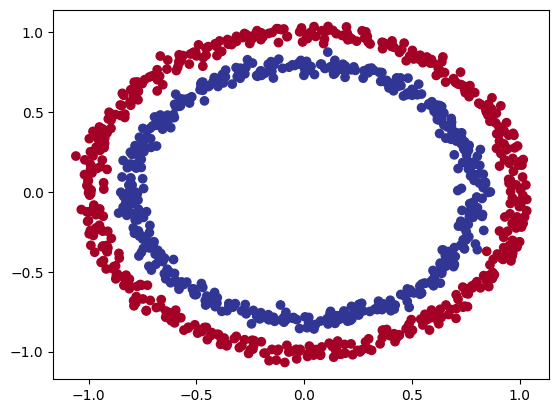
Building the Model
We can now build a neural network that allows us to do a binary classification between datapoints that belong to the blue and red circle.
tf.random.set_seed(42)
model_circles = tf.keras.Sequential([
tf.keras.layers.Dense(1, name="input_layer")
], name="model_circles")
model_circles.compile(
loss=tf.keras.losses.BinaryCrossentropy(),
optimizer=tf.keras.optimizers.Adam(learning_rate=0.01),
metrics=["accuracy"])
# earlystop_callback = tf.keras.callbacks.EarlyStopping(
# monitor='val_loss', min_delta=0.00001,
# patience=100, restore_best_weights=True)
model_circles.fit(X, y, epochs=10) # callbacks=[earlystop_callback]
model_circles.evaluate(X, y)
# 32/32 [==============================] - 0s 1ms/step - loss: 0.7405 - accuracy: 0.5050
# [0.7405271530151367, 0.5049999952316284
#
# currently the model only predicts with a 45% accuracy... worse than pure guessing with a binary choice
# adding complexity + activation functions
tf.random.set_seed(42)
model_circles_1 = tf.keras.Sequential([
tf.keras.layers.Dense(8, activation="relu", name="input_layer"),
tf.keras.layers.Dense(16, activation="relu", name="dense_layer1"),
tf.keras.layers.Dense(8, activation="relu", name="dense_layer2"),
tf.keras.layers.Dense(1, activation="relu", name="output_layer")
], name="model_circles_1")
model_circles_1.compile(
loss=tf.keras.losses.BinaryCrossentropy(),
optimizer=tf.keras.optimizers.Adam(learning_rate=0.0001),
metrics=["accuracy"])
history_1 = model_circles_1.fit(X, y, epochs=100, verbose=0)
model_circles.evaluate(X, y)
# 32/32 [==============================] - 0s 1ms/step - loss: 0.7405 - accuracy: 0.5050
# [0.7405271530151367, 0.5049999952316284]
# not much better...
# history plot
pd.DataFrame(history_1.history).plot()
plt.ylabel("loss")
plt.xlabel("epochs")
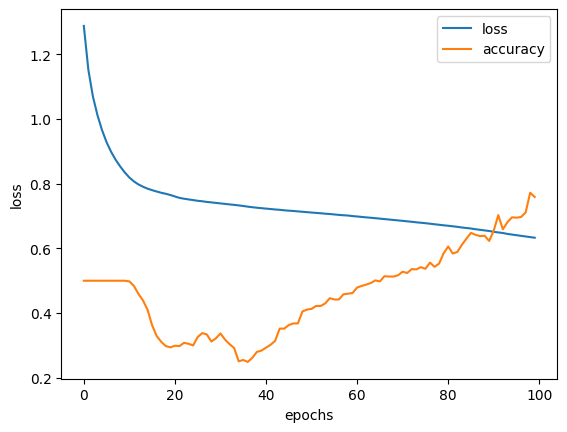
Why it Fails
# visualize predictions
# https://cs231n.github.io/neural-networks-case-study/
def decision_boundray(model, X, y):
# define axis boundries for features and labels
x_min, x_max = X[:, 0].min() - 0.1, X[:, 0].max() + 0.1
y_min, y_max = X[:, 1].min() - 0.1, X[:, 1].max() + 0.1
# create meshgrid within boundries (fresh data to run predictions on)
xx, yy = np.meshgrid(np.linspace(x_min, x_max, 100),
np.linspace(y_min, y_max, 100))
# stack both mesh arrays together
x_in = np.c_[xx.ravel(), yy.ravel()]
# make predictions using the trained model
y_pred = model.predict(x_in)
# check for multiclass-classification
if len(y_pred[0]) > 1:
# reshape predictions
y_pred = np.argmax(y_pred, axis=1).reshape(xx.shape)
else:
y_pred = np.round(y_pred).reshape(xx.shape)
# plot decision boundry
plt.contourf(xx, yy, y_pred, cmap=plt.cm.RdYlBu, alpha=0.7)
plt.scatter(X[:, 0], X[:, 1], c=y, s=40, cmap=plt.cm.RdYlBu)
plt.xlim(xx.min(), xx.max())
plt.ylim(yy.min(), yy.max())
decision_boundray(model=model_circles_1, X=X, y=y)
# the model is trying to draw a straight line through the dataset to differentiate between both classes
# it then expands this line and tries to divide both classes - and fails with a circular dataset.
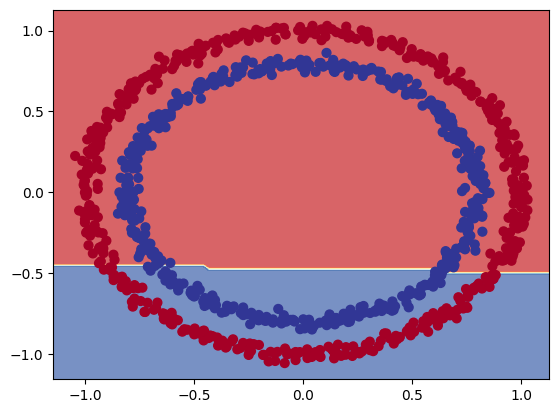
Non Linearity
Experimenting with the Tensorflow Playground to find a model that works for the non-linear classification problem.
A model useable for linear problems will remain stuck at an accuracy around 50% - purely guessing when predicting:
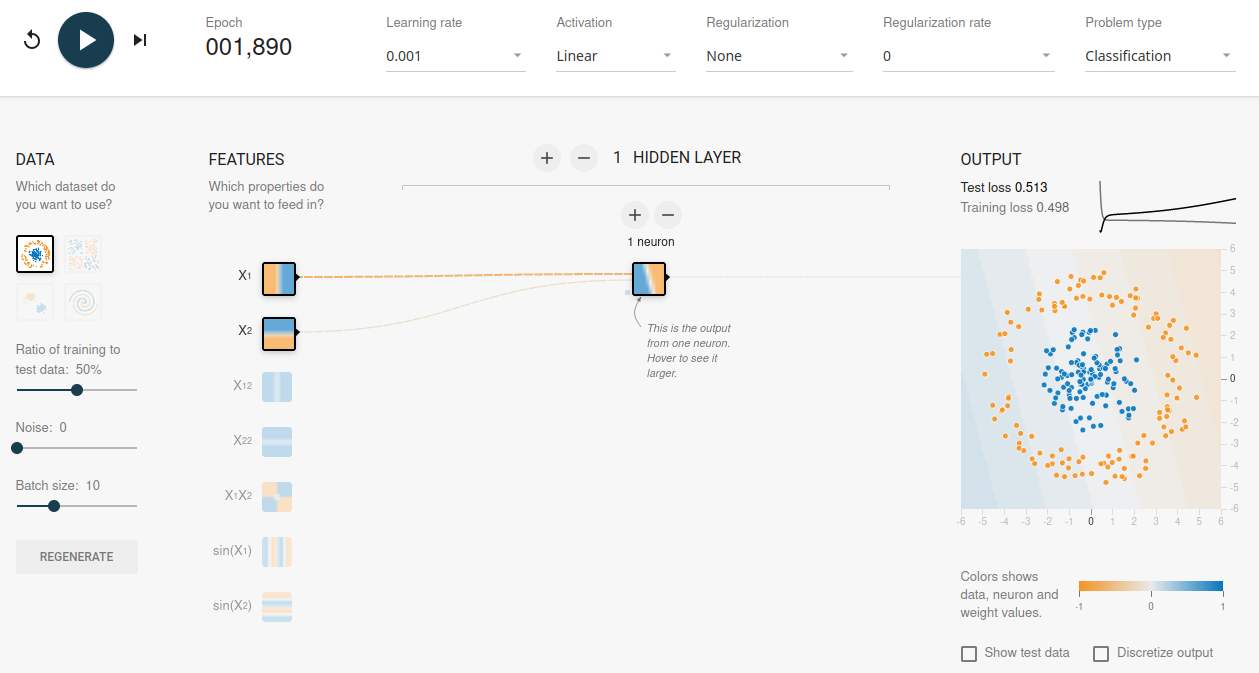
# rebuilding the model (above)
tf.random.set_seed(42)
model_circles_2 = tf.keras.Sequential([
tf.keras.layers.Dense(1, activation="linear", name="input_layer")
])
model_circles_2.compile(loss="binary_crossentropy",
optimizer=tf.keras.optimizers.Adam(learning_rate=0.001),
metrics=["accuracy"])
history_2 = model_circles_2.fit(X, y, epochs=150, verbose=0)
model_circles_2.evaluate(X, y)
# 32/32 [==============================] - 0s 1ms/step - loss: 0.7222 - accuracy: 0.4590
# [0.7222346067428589, 0.45899999141693115]
decision_boundray(model=model_circles_2, X=X, y=y)
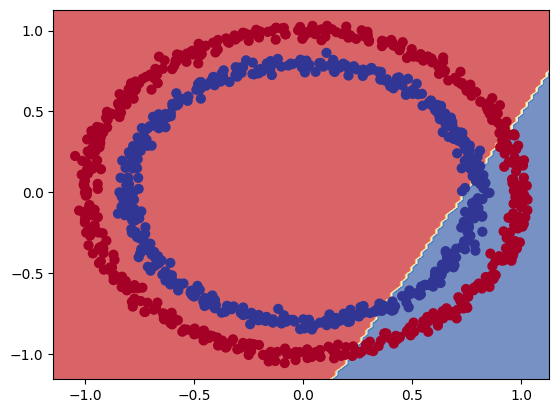
I am starting to get a good separation with the following setup after approx. 2000 epochs:
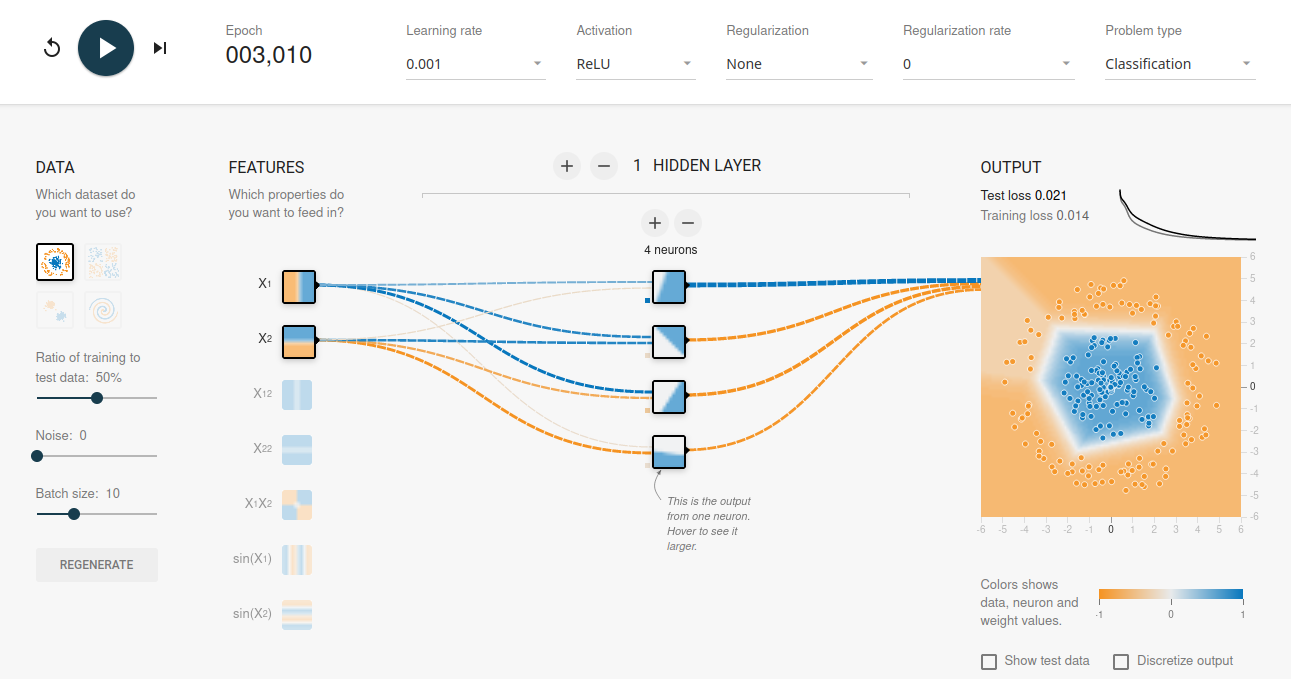
# rebuilding the model (above)
tf.random.set_seed(42)
model_circles_3 = tf.keras.Sequential([
tf.keras.layers.Dense(4, activation="relu")
])
model_circles_3.compile(loss="binary_crossentropy",
optimizer=tf.keras.optimizers.Adam(learning_rate=0.001),
metrics=["accuracy"])
history_3 = model_circles_3.fit(X, y, epochs=2000, verbose=0)
model_circles_3.evaluate(X, y)
# 32/32 [==============================] - 0s 1ms/step - loss: 0.6932 - accuracy: 0.5000
# [0.693161129951477, 0.5]
decision_boundray(model=model_circles_3, X=X, y=y)
# well, that isn't good...
# rebuilding the model (2nd attempt)
# adding an output layer with a single neuron for the binary classification
tf.random.set_seed(42)
model_circles_4 = tf.keras.Sequential([
tf.keras.layers.Dense(4, activation="relu", name="input_layer"),
tf.keras.layers.Dense(1, name="output_layer")
])
model_circles_4.compile(loss="binary_crossentropy",
optimizer=tf.keras.optimizers.Adam(learning_rate=0.001),
metrics=["accuracy"])
history_4 = model_circles_4.fit(X, y, epochs=2000, verbose=0)
model_circles_4.evaluate(X, y)
# 32/32 [==============================] - 0s 2ms/step - loss: 0.3404 - accuracy: 0.8320
# [0.34036046266555786, 0.8320000171661377]
decision_boundray(model=model_circles_4, X=X, y=y)
# much better - but not as good as the example from the tf.playground
# rebuilding the model (2nd attempt)
# adding an "sigmoid" activation for the output layer
tf.random.set_seed(42)
model_circles_6 = tf.keras.Sequential([
tf.keras.layers.Dense(4, activation="relu", name="input_layer"),
tf.keras.layers.Dense(1, activation="sigmoid", name="output_layer")
])
model_circles_6.compile(loss="binary_crossentropy",
optimizer=tf.keras.optimizers.Adam(learning_rate=0.001),
metrics=["accuracy"])
model_circles_6.fit(X, y, epochs=2000, verbose=0)
model_circles_6.evaluate(X, y)
32/32 [==============================] - 0s 1ms/step - loss: 0.0241 - accuracy: 1.0000
[0.0241051334887743, 1.0]
decision_boundray(model=model_circles_6, X=X, y=y)
# there you go...

Non-linear Activation Functions
# create a input tensor
input_linear = tf.cast(tf.range(-10, 10), tf.float32)
# visualize the tensor
plt.plot(input_linear)
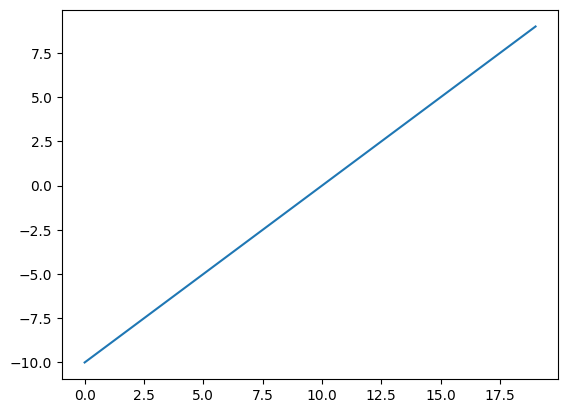
Linear Activation Function
# replicating the linear activation function linear(x) = x
def linear(X):
return X
linear(input_linear)
# <tf.Tensor: shape=(20,), dtype=float32, numpy=
# array([-10., -9., -8., -7., -6., -5., -4., -3., -2., -1., 0.,
# 1., 2., 3., 4., 5., 6., 7., 8., 9.],
# dtype=float32)>
plt.plot(linear(input_linear))
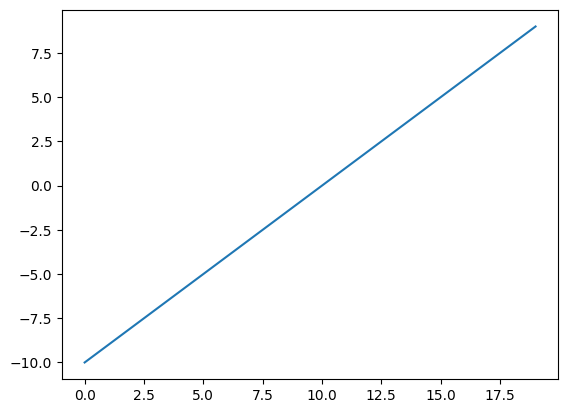
Sigmoid Activation Function
# replicating the sigmoid activation function sigmoid(x) = 1 / (1 + exp(-x))
def sigmoid(X):
return 1/(1 + tf.exp(-X))
sigmoid(input_linear)
# <tf.Tensor: shape=(20,), dtype=float32, numpy=
# array([4.5397868e-05, 1.2339458e-04, 3.3535014e-04, 9.1105117e-04,
# 2.4726230e-03, 6.6928510e-03, 1.7986210e-02, 4.7425874e-02,
# 1.1920292e-01, 2.6894143e-01, 5.0000000e-01, 7.3105854e-01,
# 8.8079703e-01, 9.5257413e-01, 9.8201376e-01, 9.9330717e-01,
# 9.9752742e-01, 9.9908900e-01, 9.9966466e-01, 9.9987662e-01],
# dtype=float32)>
plt.plot(sigmoid(input_linear))
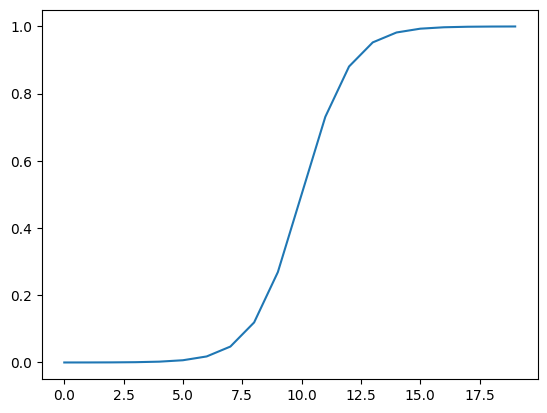
reLU Activation Function
# replicating the reLU function f(x) = 0 for x<0 and x for x>0
def relu(X):
return tf.maximum(0, X)
relu(input_linear)
# <tf.Tensor: shape=(20,), dtype=float32, numpy=
# array([0., 0., 0., 0., 0., 0., 0., 0., 0., 0., 0., 1., 2., 3., 4., 5., 6.,
# 7., 8., 9.], dtype=float32)>
plt.plot(relu(input_linear))
